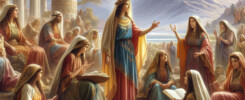Reading and studying the plates of brass, including 4 Sefer Moses, by the gift and power of the Holy Spirit is said to help individuals gain wisdom, knowledge, and understanding. The purpose of preserving these records, all of the writing on the brass plates, is that Zion might be built, and that the Creator might return to complete His creation. The plates are described as the “manna to feed Israel” during a time of famine in the Last Days. 4 Moses, as found within, is a collection of five distinct books:
1. The Book of Testimony
This is also the primary title given by the translator (David Ferriman) to 4 Sefer Moses. While it is listed as one of the five collected books, it also serves as the name for the entire collection of teachings of Moses and Zipporah. The provided table of contents shows the initial chapters of 4 Sefer Moses, starting with Chapter 1, are titled under the main heading “4 Sefer Moses”. Chapter 1 is titled “The Covenant of the Passover”. This chapter describes the blood on the doorposts as a token that causes the plague to pass over the Israelites. This day is to be kept as a memorial feast throughout their generations. Chapter 3 is “The Covenant of YHVH: The Decalogue,” listing the Ten Words or commandments. Chapter 4 is “The Covenant of Israel,” which lists further commandments, including having no other elohim, making no molten images, keeping the Feast of Unleavened Bread, considering the first desire as belonging to YHVH, and observing the Sabbath rest. Chapters like these appear to constitute the core “Testimony” of God’s covenant and instructions.
2. The Torah of the Tabernacle
This is listed as one of the five books collected in 4 Moses. The name suggests it would contain teachings and instructions related to the Tabernacle, likely for the Levites. Chapter 35 of 3 Sefer Moses in the larger work does provide details regarding the building materials and consecration of priests and priestesses for the Tabernacle. The “Torah of the Tabernacle” within 4 Moses contains additional or collected teachings on this topic, but the specific content is not detailed in the provided excerpts from 4 Moses itself.
3. The Chereb of Moses
 This section starts at Chapter 30 of 4 Sefer Moses. Chapter 30 itself is titled “The Chereb of Truth.” The translator explains that “Chereb” is Hebrew for “sword” or “tool.” Moses was given the chereb, a staff, by God through the angel of YHVH. Chapters 30-36 of 4 Moses lay out “The Chereb of Moses.” Obtaining the chereb involves a specific three-day fast with restrictions on food and drink, washing hands in salt, eating unleavened bread, drinking only water, and bathing. Moses speaks of it in conjunction with gaining wisdom, knowledge, and understanding. It appears to be a spiritual tool or power associated with truth and divine understanding.
This section starts at Chapter 30 of 4 Sefer Moses. Chapter 30 itself is titled “The Chereb of Truth.” The translator explains that “Chereb” is Hebrew for “sword” or “tool.” Moses was given the chereb, a staff, by God through the angel of YHVH. Chapters 30-36 of 4 Moses lay out “The Chereb of Moses.” Obtaining the chereb involves a specific three-day fast with restrictions on food and drink, washing hands in salt, eating unleavened bread, drinking only water, and bathing. Moses speaks of it in conjunction with gaining wisdom, knowledge, and understanding. It appears to be a spiritual tool or power associated with truth and divine understanding.
4. The Wisdom of Zipporah
This is listed as one of the five books collected in 4 Moses. The sources state it appears to be the writings of Moses’ wife, the prophetess Zipporah, as collected by Moses. Zipporah is described as a High Priestess and a helper and support to Moses. She is mentioned alongside Moses as receiving and giving the teachings found in 4 Sefer Moses. She also led the Priestesses and taught the women in the ways of YHVH. Her wisdom and teachings are likely integrated throughout the book, given her role as a co-teacher with Moses, but this section seems to be written by her.
5. The Law of Moses
This is listed as one of the five books collected in 4 Moses. The Table of Contents shows a section titled “The Law of Moses, The Judgments of Moses” starting at Chapter 43 of 4 Sefer Moses. Chapter 43 is titled “The Judgments of the Clean and the Unclean,” which includes laws about which animals may be eaten, specifying those that part the hoof, are cloven-footed, and chew the cud. It explicitly states not to eat the camel because it is a servant and bears burdens. These judgments are given so Israel can keep the unclean from the clean and avoid plagues. Chapter 44, “The Judgments on Servants, Masters and Marriages,” details laws regarding Hebrew servants, stating they shall serve six years and go free in the seventh, and that Israel shall not have slaves. This book appears to contain the specific judgments and practical laws given by Moses
Conclusion
4 Sefer Moses is a comprehensive presentation of YHVH’s covenant, laws, and spiritual guidance as delivered through the joint ministry of Moses and Zipporah. It provides the essential divine instructions for Israel to live as a holy people, understand spiritual power or “Chereb,” maintain practical righteousness, the “Law,” and benefit from prophetic wisdom the”Wisdom of Zipporah.” The book serves as a foundational testimony and guide for Israel, crucial for their spiritual sustenance or “manna” and preparation for the building of Zion and the Creator’s return in the Last Days


